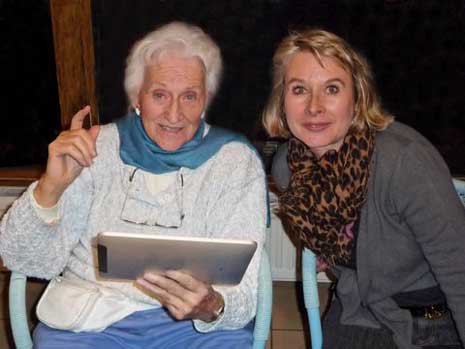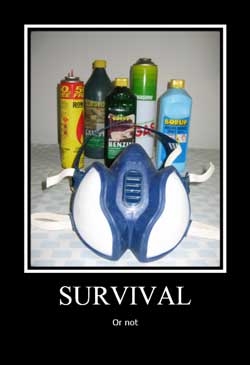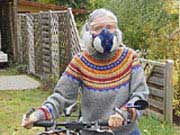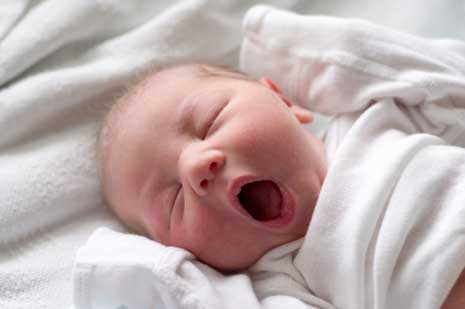An icon of environmental medicine visits Germany
Evidence for the causes of environmental diseases have been around for a long time
The doctor and scientist Doris Rapp is one of those who not only practice environmental medicine, but has also made environmental medicine the most important thing in her life. The American spent two weeks in Germany. The reunion with Prof. Rapp was very productive and we were lucky enough to spend a beautiful day on the Moselle. Here is a small summary.
Researcher documented environmental disease
I met Prof. Rapp for the first time at a congress in Bad Emstal about 18 years ago. It was a crucial experience. In her presentation, she showed a video about a teacher who became ill from contaminated carpeting in the school. The teacher was filmed during a reaction to contaminated dust from the carpet. This video vividly conveys to the viewer what MCS is and what a reaction can look like. At that time I was at the very beginning of my own illness and had had similar reactions to certain pesticides. The teacher experienced convulsions and fell unconscious. I thought “my goodness, that’s me, that’s exactly like me, that’s what you have…“ After the lecture I spoke with Prof. Rapp and that was the beginning of an ongoing exchange of information and an interesting friendship. We met again at conferences in Germany, Holland and in the U.S., visited each other in Germany and the United States and exchanged e-mails. When I visited her in Scottsdale, she showed me one of her video archives. She had stored thousands of videos of children whom she had treated. They showed the patients during and after therapy and during testing of foods, mold, pollen, dust mites or chemicals. They displayed impressive evidence that can remove any last doubts as to the existence of environmental illnesses and allergies.
We can no longer ignore environmental illnesses
Dr. Binz and his wife invited the environmental doctor for this most recent visit to Germany. We had actually arranged to meet for a trip along the Moselle, which would start before lunch. We had a warm reunion and before we knew it we had already exchanged information and ideas and were in the midst of planning for future projects.
“I’m over 80 years old now and have no children, I don’t really need to be doing all this and I could be enjoying my peace at this age, but I see what’s going on, and I simply cannot remain silent. We have so many chemicals in our environment, in the food we eat, in the water we drink and the air that we are constantly breathing. They affect each of our body systems and we can no longer ignore this. Almost every second person in my country has cancer and that is just not acceptable”, says Doris Rapp.
“The politicians and the public must realize the impact the flood of chemicals has on us and no one should keep insisting that we do not know where all the increasing diseases that occur are coming from. The evidence is there. We have animal testing to prove it. That’s why, as a doctor, I ask: How much more has to happen before we admit to the real causes? I won’t accept hearing when one says, “Yes, but there’s nothing we can do about it.” Yes, there is, because you can educate yourself and there’s a hell of a lot you can do,” says Prof Rapp, who is enraged about the current situation.
Solutions are often very simple
Prof. Rapp is no one who can be at odds with the world and ignore the solutions. She is in the process of writing another book. “It will be a small book, only 30 pages. Every reader can easily understand how he/she can shape his environment in order to stay healthy. The tips in this book will not cost anyone a fortune, they can easily be implemented without major expense. It will help anyone who wants to change something and wants to improve his health. The doctor cites two examples:
“Many people react to foods, but are not sure towards which foods. Expensive tests are not necessary. I advise people to think about what they eat most, foods that they downright crave. Experience has shown that these are the foods that are eaten every day and most likely those which cause reactions. The solution: omit the suspected food for a week. You can test one food after another. This costs nothing! ”
“Some people live in a house that is contaminated with pollutants or contaminated by mold. My experience is that five out of seven people can improve their health by 70% if they obtain a high quality air cleaner that is capable of filtering hundreds of chemicals from the air in your home. Such a device may cost a bit, but I have often seen patients who got better over night. So it’s worth it if you are unable to directly move out of the apartment or house.”
The new book will be published this year, and Professor Rapp has authorized me to translate it into German. She also gave me permission to translate videos and other books into our language, contributing knowledge to allergy sufferers and chemically sensitive people in the German-speaking countries, helping them to find a way back into life.
A trip along the Moselle
During the drive to the historic Moselle wine village, Bernkastel, to Traben-Trabach and the drive back to Trier, Prof. Rapp was bursting with innovative ideas that we will begin to put into action in the next few months and they will benefit the environmentally ill in many ways.
Author: Silvia K. Müller, CSN – Chemical Sensitivity Network, 12 September 2011
Related Articles:







